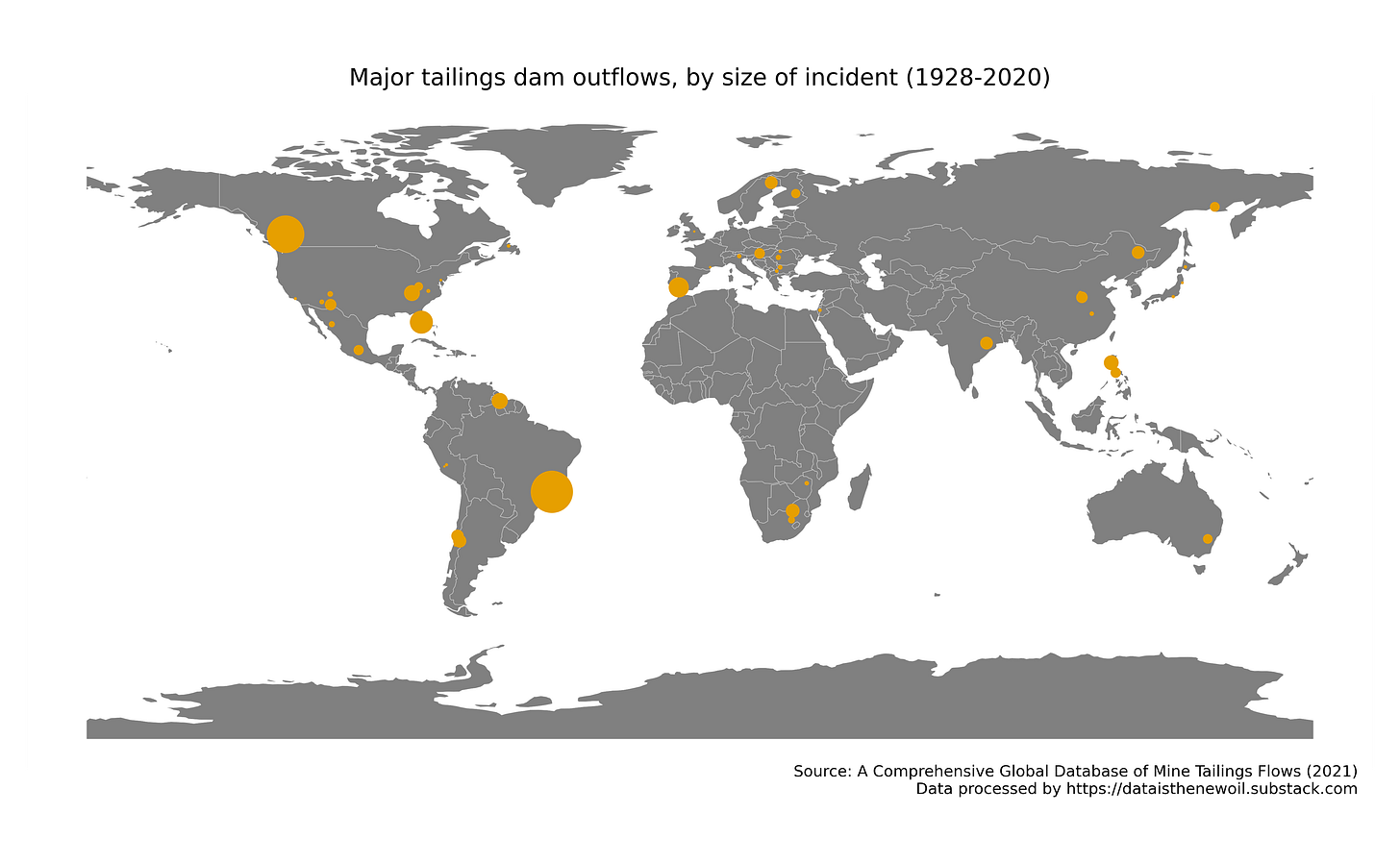Data Is The New Oil - 04.03.2021 Update
Tailings dam failures, Snow depth, CO2 abatement and Global deforestation.
🌊 Tailings dam failures. Tailings dams are used to store the toxic byproducts of mining operations and rank among the largest engineered structures on earth. Of the 3,000 or so active impoundments, between 2 and 5 fail each year. This database lists 63 major tailings incidents between 1928 and 2020, including the type of tailing, its height, volume and the circumstances surrounding the event. The 2019 Feijão tailing collapse in Brazil caused 272 deaths and catastrophic environmental damage, but the database also lists other, larger incidents.
🏔️ Snow depth. Researchers put together a near 40-year time series of snow cover at more than 2,000 European medium and high-altitude stations. Snow patterns in mountains are changing rapidly under the influence of climate change, with adverse consequences for local habitat and rivers. Separately, a paper published in Nature magazine attempts to measure future snow melt patterns in a warming world.
🏭 CO2 abatement. The Dutch Ministry of Economic Affairs and Climate published a comprehensive database of CO2 abatement costs for several technologies, from heat pumps to hydrogen electrolysis, geothermal energy and carbon capture and storage. It is used to determine the subsidy associated with each scheme. A separate paper reviews the academic literature on energy factors and CO2 intensities. It finds that 72% of publications consider only a single country, 86% apply a purely retrospective perspective and 75% ignore electricity imports from surrounding countries.
🌳 Global deforestation. Our World in Data created a map of imported deforestation, using data from a 2019 study by researchers Florence Pendrill et al. Many countries in Asia, Europe and North America are net importers, meaning that the deforestation embedded in their imports is higher than the amount of forestry regrown locally. Today, most deforestation occurs in the tropics. 70% of this is driven by demand in domestic markets, and the remaining 30% for traded products. Also check out this dataset of European forestry changes over the period 1986-2020.
Other Data Updates
☔ The French weather service has started publishing a live database of weather warnings in text and picture format.
🚘 Researcher Chao He published the internal recordings of an electric vehicle driving in real-world conditions in the streets of Beijing. The dataset monitors speed, mileage and voltage every 10 seconds.
💡 USAid published a dataset showing the number of citizens with access to electricity in Cameroon.
♳ Eurostat updated its dataset of plastic recycling to include the year 2018.
🏭 Researcher Leon Schwenk-Nebbe released a dataset of historical CO2 emissions from the European electricity sector.
🔌 Ernesto Aguilar Madrid shared a high-frequency electricity load dataset suitable for machine learning.
Worth a Read
🚧 The albedo–climate penalty of hydropower reservoirs
Researchers compiled a global database of hydropower reservoirs to estimate the albedo effect ie, the amount of land replaced by water that results in lesser reflectance of the sun on the earth. Hydropower dams are net contributors to global warming in their early years.
📉 The economic impact of weather and climate
A new conceptual framework to disentangle the impacts of weather and climate on economic activity and growth. Weather anomalies increase inefficiency in poor and hot countries.
🔋 Energy Storage Capacity vs. Renewable Penetration: A Study for the UK
Using 9 years of demand and generation data with a 1-hour resolution, this study concludes that the UK would need a power storage capacity of approximately 43 TWh to decarbonise its electricity supply. Based on current costs, this translates into an investment of £165 billion or 7% of GDP.
💨 Long-term assessment of offshore wind energy in the south and southeast coasts of China
A study of wind resources in Southeast Asia. Luzon Strait and Taiwan Strait have higher wind energy potential than other areas, but the wind variability in Luzon Strait makes it unsuitable for baseload power production.
💨 Geospatial mapping of micro-wind energy for district electrification in Ghana
Comprehensive mapping of wind resources in Ghana, using wind speed data. Areas along the coast and the middle belt areas show high potential.
🤖 An empirical analysis of applications of artificial intelligence algorithms in wind power technology innovation
An analysis of the application of AI algorithms in wind power technology patents.
If you do know people who might enjoy this newsletter, I would really appreciate it if you would forward it on. Don't hesitate to contact me (oliv.lejeune@gmail.com) if you have any dataset suggestions or comments about this note. Thanks for reading.





